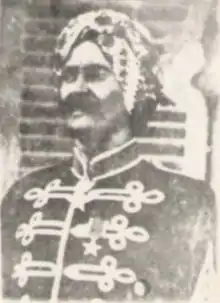Ali Yusuf Kenadid
Ali Yusuf Kenadid (Somali: Cali Yuusuf Keenadiid, Arabic: علي يوسف كينايديض) was a Somali ruler. He was the second Sultan of the Sultanate of Hobyo.
| Ali Yusuf Kenadid علي يوسف كينايديض | |
|---|---|
| Sultan of the Sultanate of Hobyo | |
 | |
| Reign | early 1900s–1910 |
| Predecessor | Yusuf Ali Kenadid |
| Successor | n/a |
| Father | Yusuf Ali Kenadid |
| Religion | Islam |
History
Ali Yusuf was born into a Majeerteen Darod family. His father, Sultan Yusuf Ali Kenadid, was the founder of the Sultanate of Hobyo centered in present-day northeastern and central Somalia. The polity was established in the 1870s on territory carved out of the ruling Majeerteen Sultanate (Migiurtinia).[1] Ali Yusuf's brother, Osman Yusuf Kenadid, would go on to invent the Osmanya writing script for the Somali language.[2]
In an attempt to advance his own expansionist objectives, Kenadid père in late 1888 entered into a treaty with the Italians, making his realm an Italian protectorate.[3] The terms of the agreement specified that Italy was to steer clear of any interference in the sultanate's administration.[4]
However, the relationship between Hobyo and Italy soured when the elder Kenadid refused the Italians' proposal to allow a British contingent of troops to disembark in his Sultanate so that they might then pursue their battle against the Somali religious and nationalist leader Mohammed Abdullah Hassan's Dervish forces.[3] Viewed as too much of a threat by the Italians, Sultan Kenadid was eventually exiled to Aden in Yemen and then to Eritrea, as was his son Ali Yusuf, the heir apparent to his throne.[5]
Notes
- Helen Chapin Metz, Somalia: a country study, (The Division: 1993), p.10.
- Diringer, David (1968). The Alphabet: A Key to the History of Mankind, Volume 1. Funk & Wagnalls. pp. 235–236. ISBN 1452299374. Retrieved 14 December 2014.
- The Majeerteen Sultanates
- Issa-Salwe (1996:34–35)
- Sheik-ʻAbdi (1993:129)
References
- Sheik-ʻAbdi, ʻAbdi ʻAbdulqadir (1993). Divine madness: Moḥammed ʻAbdulle Ḥassan (1856-1920). Zed Books. ISBN 0-86232-444-0.CS1 maint: ref=harv (link)
- The Majeerteen Sultanates